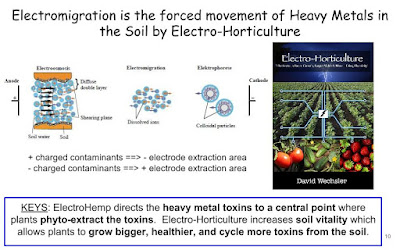Organic Remediation and Toxic Cleanup Its Not Rocket Science - Its Phyto Science. The magic happens in the roots of the plants Naturally with Phytoremediation
Wednesday, January 18, 2023
Monday, January 16, 2023
Electricity Production by Geobacter sulfurreducens Attachedto Electrodes
here is the science behind the Electrohemp Pollution Disposal Energy Fuel Cell:
Thursday, November 24, 2022
yet another natural remedy
here is yet another example: nature has a cure for what ails mankind! thank you for sharing.
— systembuster (@stlsystembuster) November 24, 2022
"... other proteins also worked, so it may be possible to utilize those as to not strain the {egg} market as much. An even bigger concern is water purification [removes salt] ... " https://t.co/CULB5BwJz9
— systembuster (@stlsystembuster) November 24, 2022
So if plants remove toxins its called Phytoremediation.
What will be the term invented for when Eggs or Proteins remove toxins? - egremediation or proremediation
So if plants remove toxins its called #Phytoremediation.
— systembuster (@stlsystembuster) November 24, 2022
What will be the term #invented for when Eggs or Proteins remove toxins? #Poll
Wednesday, November 23, 2022
Small Modular Nuclear Reactors and Likely Human Health Effects
The "new", smaller reactors now being pushed by the nuclear industry are not new. Some, like the lightwater reactor highlighted in this presentation, exist in larger form today and have a track record of pollution and health impacts, particularly for pregnancy, children and indigenous populations.
Building more of these reactor types will create more long-lasting problems for human health and the environment while failing to address the climate crisis. A presentation by Cindy Folkers, radiation and health specialist, Beyond Nuclear.
Monday, November 21, 2022
Saturday, November 19, 2022
The Pollution Solution
Thursday, November 17, 2022
Jana Elementary Nuclear News Florissant MO
typo: that is $49.5 Million. @TeamSaintLouis has requested that the current $49,500,000 maximum contract amount be increased by
— systembuster (@stlsystembuster) November 17, 2022
to allow the cost-plus-fixed-fee task order W912P921F0260.
image When Scientist Lie People Die source:https://t.co/roxrugvLOT pic.twitter.com/ke2RTFatgw
I stand by what I said in this tweet. When I get some testing tools I will test this whole city and north county and share the info to the world. https://t.co/RoDimgI7UC
— systembuster (@stlsystembuster) November 17, 2022
I stand by what I said in this tweet. When I get some testing tools I will test this whole city and north county and share the info to the world. https://t.co/RoDimgI7UC
— systembuster (@stlsystembuster) November 17, 2022Join the FUSRAP team for a townhouse at the Florissant Municipal Court tonight, from 5 to 8 p.m. to review the preliminary results from sampling efforts for radioactive material at Jana Elementary School.
Presentation will be from 6 - 7 p.m CST.
— systembuster (@stlsystembuster) November 17, 2022
Please email questions to STLFUSRAP@usace.army.mil #JanaElementary #Nuclear #PlayGround
anyone can attend for free ! Here is the Jana Elementary School Nuclear Report from USARMY FUSRAP Facebook Live Link and invitation: https://fb.me/e/325DvwNfg
 |
| Here is the Jana Elementary School Nuclear Report from USARMY FUSRAP Facebook Live Link and invitation: https://fb.me/e/325DvwNfg |
h/t @TeamSaintLouis FUSRAP ACE https://t.co/sklsScPLDp
— systembuster (@stlsystembuster) November 17, 2022
The Florissant Municipal Court is located at 4575 Washington St., Florissant, MO 63033.
In advance of tonight’s public engagement, the St. Louis District has posted some of the materials that will be shared and discussed.
These materials, along with additional information on these efforts, can be accessed here: www.mvs.usace.army.mil/Missions/FUSRAP/Jana-Elementary/
For more information: https://www.mvs.usace.army.mil/.../community-about.../
U.S. Army Corps of Engineers, Headquarters | Mississippi Valley Division (US Army Corps of Engineers)
@TeamSaintLouis that $49,500,00 contract
— systembuster (@stlsystembuster) November 17, 2022
that allows the cost-plus-fixed-fee task order W912P921F0260, St Louis FUSRAP
project, currently underway- would seem to buy Scientist who maybe not telling the truth. https://t.co/ZnDEVrND0a Which Govt Agency is fixing the books? @EPA

Search This Blog
ElectroHemp Introduction
ElectroHemp Hazardous Waste Remediation Intro
ElectroHemp BioRad Hazardous Waste Cleanup Introduction ElectroHemp - BioRad CleanUp 5 Stage Phytoremediation Treatment Train - Remove...

-
while reading this I realized the EPA are addressing the spread of the toxins but not the cause of the toxins. tsk tsk tsk @EPA Are you s...
-
ElectroHemp BioRad Hazardous Waste Cleanup Introduction ElectroHemp - BioRad CleanUp 5 Stage Phytoremediation Treatment Train - Remove...
-
If only more business cared about the environment as much as IKEA does. Most everyone has heard that the St Louis IKEA Store is powered ...



.jpeg)





